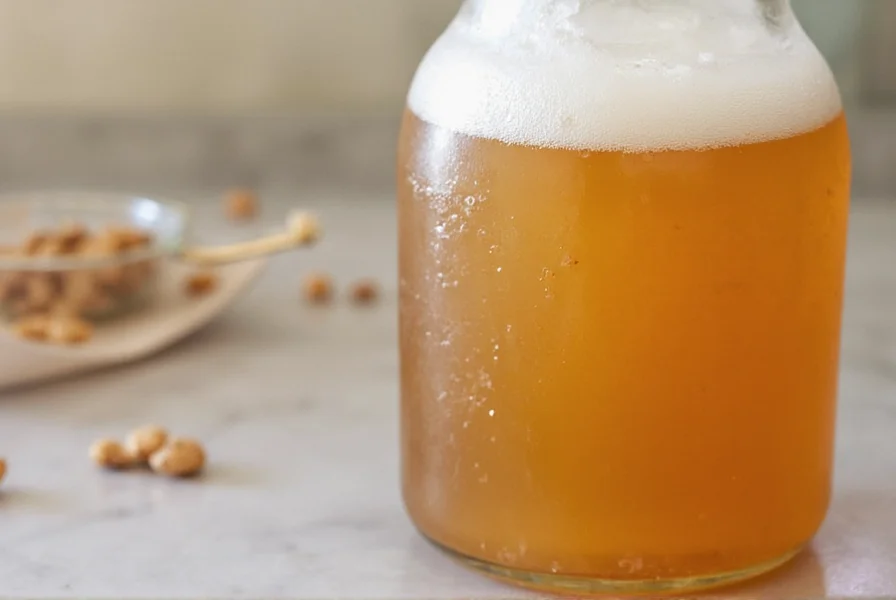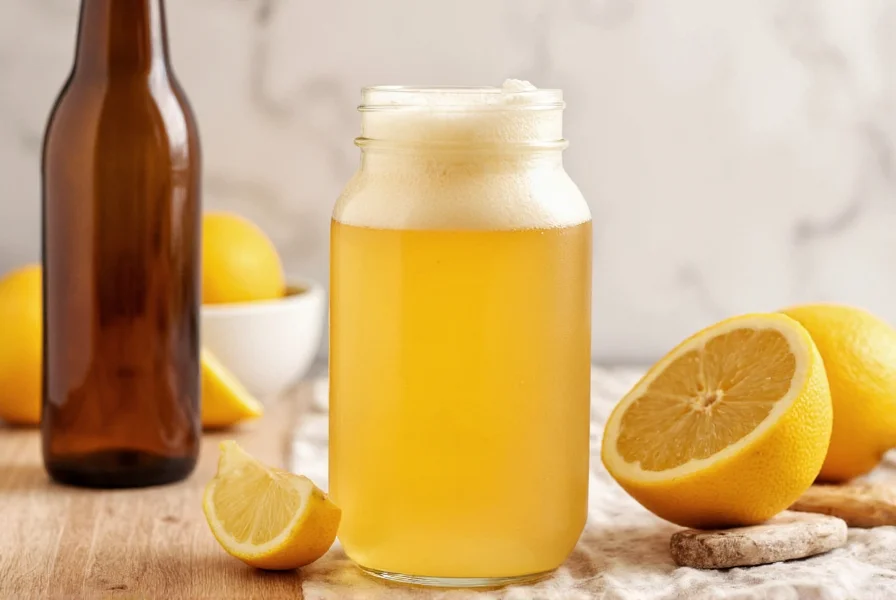Homemade ginger beer is a naturally fermented beverage made from fresh ginger, sugar, water, and a fermentation agent like yeast or a ginger beer plant. When prepared correctly with proper sanitation and fermentation monitoring, it produces a refreshing, slightly effervescent drink with minimal alcohol content (typically under 0.5% ABV) that's safe for most people to enjoy.
Making ginger beer at home connects you to a centuries-old tradition of natural fermentation. Unlike commercial versions loaded with preservatives and artificial flavors, homemade ginger beer lets you control every ingredient while creating a probiotic-rich beverage with digestive benefits. The process requires just basic kitchen equipment and about 7-10 days of fermentation time, yielding a customizable drink that can range from mildly spicy to intensely gingery based on your preference.
The Science Behind Successful Ginger Beer Fermentation
Ginger beer's magic happens through natural fermentation. When you combine grated ginger, sugar, and water, you create an environment where wild yeast and bacteria convert sugars into carbon dioxide (creating fizz) and trace amounts of alcohol. The key to consistent results lies in understanding three critical factors:
- Ginger quality - Fresh, organic ginger root contains natural enzymes and wild yeast essential for fermentation
- Sugar balance - Too little sugar prevents proper carbonation; too much creates excessive pressure
- Temperature control - Ideal fermentation occurs between 68-75°F (20-24°C)
Essential Ingredients for Authentic Homemade Ginger Beer
Quality ingredients make the difference between flat soda and vibrant ginger beer. Here's what you'll need:
| Ingredient | Amount | Function | Substitution Options |
|---|---|---|---|
| Fresh ginger root | 4 oz (115g) | Provides flavor, enzymes, and natural yeast | None - dried ginger won't work |
| White sugar | 1 cup | Food for fermentation microbes | Honey, maple syrup (affects flavor) |
| Filtered water | 4 cups | Base liquid | Spring water (avoid chlorinated tap water) |
| Lemon juice | 1/4 cup | Acidity regulator | Lime juice or citric acid |
| Ginger beer plant or yeast | 1 tbsp or 1/4 tsp | Fermentation starter | Water kefir grains (for continuous brewing) |

Step-by-Step Ginger Beer Making Process
Follow these precise steps for reliable results when making traditional ginger beer at home:
Stage 1: Creating the Ginger Tea Base (Day 1)
- Peel and finely grate 4 ounces of fresh ginger root
- Combine grated ginger with 1 cup sugar and 2 cups water in a saucepan
- Bring to a gentle simmer (do not boil) for 15 minutes
- Remove from heat and add juice of 1 lemon
- Cool completely to room temperature (critical step - warm liquid kills yeast)
Stage 2: Primary Fermentation (Days 2-5)
- Pour cooled ginger tea into a clean 1-gallon glass jar
- Add 2 more cups filtered water and your fermentation starter
- Cover with breathable cloth secured with rubber band
- Stir twice daily for 3-5 days at room temperature
- Look for bubbles and slight cloudiness indicating active fermentation
Stage 3: Bottling and Carbonation (Days 6-10)
- Straight ginger beer through fine mesh strainer into clean bottles
- Leave 1-2 inches headspace in each bottle
- Seal with airtight caps (swing-top bottles work best)
- Store at room temperature for 2-4 days for carbonation
- Refrigerate to slow fermentation and enjoy within 2 weeks
Critical Safety Considerations for Homemade Ginger Beer
Safety must be your priority when fermenting beverages at home. These guidelines prevent dangerous pressure buildup:
- Always use thick glass bottles designed for carbonation (never thin wine bottles)
- "Burp" bottles daily during carbonation phase by slightly opening caps
- Store bottles in a cardboard box to contain potential explosions
- Discard if you detect mold, off smells, or unusual colors
- Keep refrigerated after carbonation completes to prevent over-pressurization
Troubleshooting Common Ginger Beer Problems
Even experienced home fermenters encounter issues. Here's how to fix the most frequent problems:
| Problem | Causes | Solutions |
|---|---|---|
| No carbonation | Dead yeast, cold temperature, insufficient sugar | Add 1 tsp sugar per bottle, move to warmer spot (70-75°F) |
| Excessive alcohol | Over-fermentation, too much sugar | Refrigerate immediately, reduce sugar in next batch |
| Vinegar taste | Acetobacter contamination | Discard batch, improve sanitation, use lemon juice |
| Bottle explosions | Over-carbonation, weak bottles | Always burp bottles, use proper glass, refrigerate sooner |
Customizing Your Homemade Ginger Beer
Once you've mastered the basic recipe, experiment with these flavor variations:
- Tropical twist - Add 1/2 cup pineapple juice during bottling
- Spiced version - Include cinnamon sticks and cloves during ginger tea stage
- Herbal notes - Steep fresh mint or basil leaves during primary fermentation
- Dry ginger beer - Reduce sugar by 25% for less sweetness
- Non-alcoholic option - Refrigerate after 24 hours of primary fermentation
Storage and Serving Recommendations
For optimal flavor and safety, follow these storage guidelines:
- Refrigerate immediately after desired carbonation level is reached
- Consume within 2-3 weeks for best flavor (continues fermenting slowly)
- Chill thoroughly before serving (ice-cold masks any minor alcohol notes)
- Pour carefully to avoid disturbing sediment at bottle bottom
- Serve in champagne flutes to appreciate the natural carbonation
Frequently Asked Questions
How long does homemade ginger beer last in the refrigerator?
Properly stored homemade ginger beer maintains best quality for 2-3 weeks in the refrigerator. The cold temperature slows but doesn't stop fermentation, so check bottles periodically for pressure buildup. After 3 weeks, flavor may become overly sour or vinegary as secondary fermentation continues.
Can children drink homemade ginger beer?
Yes, children can safely consume homemade ginger beer when prepared using proper fermentation techniques. The alcohol content typically remains below 0.5% ABV - similar to many fruit juices that naturally ferment. For completely non-alcoholic versions, refrigerate after 24 hours of primary fermentation before significant alcohol production occurs.
Why did my ginger beer become too alcoholic?
Excessive alcohol content usually results from over-fermentation. This happens when you leave the ginger beer at room temperature too long during primary or secondary fermentation. To prevent this, monitor bubbles closely and refrigerate once desired carbonation level is reached. Using less sugar (10-15% reduction) also helps control alcohol production while maintaining carbonation.
What's the difference between ginger beer and ginger ale?
Traditional ginger beer undergoes natural fermentation using ginger, sugar, and a starter culture, resulting in complex flavors and natural carbonation. Most commercial ginger ales are artificially carbonated soft drinks made with ginger flavoring rather than real ginger root. Homemade ginger beer has a more robust, spicy flavor profile and contains beneficial probiotics absent in most ginger ales.
Can I use dried ginger powder instead of fresh ginger?
No, dried ginger powder won't work for traditional fermented ginger beer. Fresh ginger root contains natural enzymes and wild yeast essential for proper fermentation that aren't present in dried powder. Powdered ginger also creates a different flavor profile and lacks the fibrous material that helps with the fermentation process. For authentic results, always use freshly grated ginger root.











 浙公网安备
33010002000092号
浙公网安备
33010002000092号 浙B2-20120091-4
浙B2-20120091-4